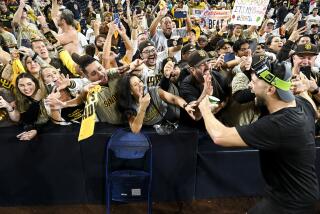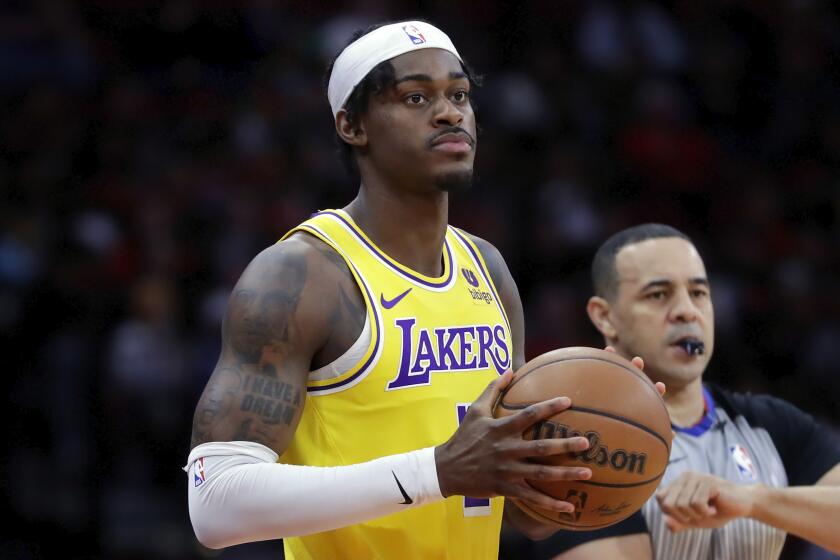SUPER BOWL SPECIAL : It’s More Than a Game, and San Diego Is Ready
- Share via
The Idea sprouted in Gene Klein’s mind: Why not have the Super Bowl for San Diego?
In May, 1984, the Idea became Reality: The National Football League’s fathers were persuaded by the then-owner of the Chargers to bring their extravagant road show to the nation’s seventh-largest city.
That’s when the tough grunt work began.
For almost 4 years, it has been meeting after meeting, plan after plan, report after report.
For almost 4 years, it has been the search for the perfect party design.
For almost 4 years the Super Bowl has been looming over the city, with already-busy officials and business leaders tackling problems and working up game plans for possible windfall profits.
It’s finally here.
America’s megagame and the Mardi Gras-like trappings that precede it have arrived in San Diego.
Local officials exude confidence that the city has done its job, that the blueprint for success is complete. Yes, there may be glitches, but civic leaders believe there won’t be enough of them to dampen the spectacle. Visitors, they think, will leave San Diego wanting to return.
Like a debutante, the city has for months gussied up for its unprecedented entry onto the national and international stage. It wants to be noticed.
“This really is the first significant national and international event (planned for) San Diego . . . since the (1972) Republican National Convention,” says Lee Grissom, head of the San Diego Chamber of Commerce and a member of the city’s Super Bowl Task Force.
That’s the year the GOP left San Diego at the altar. Back then, Richard Nixon was a first-term president, Watergate was just another expensive condo project, and San Diego was preparing for the convention it had been awarded the year before.
But the convention was taken away and given to Miami Beach after weeks of controversy, not the least of which revolved around a leaked International Telephone & Telegraph memo.
ITT, then in the throes of a federal antitrust action, wanted the Administration to drop its investigation. In return, the corporation pledged to underwrite a large portion of the GOP convention in San Diego.
So much for the city’s brief introduction to the vagaries of national politics. But that’s all history--16 Super Bowls have been played since then. Times have changed, as have the opportunities, the hoopla and hype surrounding the game.
“This is great exposure for the city to go through,” says Grissom. “Some things will work smoothly and perfectly . . . and in hindsight, we’ll also find some things we would have done differently.”
He adds: “Is San Diego ready for prime time? We’ll find out.”
According to people ranging from the NFL and task force members to shopkeepers and restaurant owners, the Super Bowl’s impact on San Diego--both tangible and intangible--will be greater than the city’s only other major brush with a national professional sports championship, the 1984 World Series between the Padres and the Detroit Tigers.
While that event was characterized by the wild frenzy of thousands of Padres fans packed into San Diego Jack Murphy Stadium for the Series, very few local residents will be able to get anywhere near the stadium Sunday, let alone attend the game.
Of course, the city has had other professional championship contests--there were the early ‘60s and the triumphant Chargers of the old American Football League, and, more recently, the Sockers, kings of indoor soccer. But the media energy emanating from those events was, in comparison to the Super Bowl, simply low voltage.
For days now, the city has been the recipient of massive publicity, both in this country and abroad.
For a tourist city like San Diego, that exposure is invaluable. But as much as the pictures of palm trees, beaches and boats impart a strong direct message, local officials hope the thousands of stories both written and broadcast will also leave a more subtle message.
“Is this a sleepy village near Tijuana or a vital, progressive city . . . a city that is growing?” asked G.E. (Vinny) Vinson, chairman of the board of
Rosenfield-Vinson Advertising. He is founding president of the Holiday Bowl, the annual December contest between university teams.
Vinson knows the difference between the two events.
“There will be more corporate heads (visiting) in that week than have been in San Diego in five years,” he said. “The big boys from the big corporations.”
As important as subliminal messages might be, the Super Bowl’s direct impact on San Diego can be measured through hard currency, or--to borrow a line from Los Angeles Raiders defensive back Lester Hayes--by deceased presidents (Washington, Lincoln, Grant, Jackson), millions and millions of deceased presidents.
‘Movers and Shakers’
The almost 80,000 people expected to descend on San Diego to take part in a plethora of pregame parties, dinners and events--the vast majority of them from out of town--have incomes equivalent to the top 25% of the tourists who usually visit the city.
“Those who come are movers and shakers,” said Al Reese, spokesman for the ConVis, the city’s Convention & Visitors Bureau. “I think this can do a lot to enhance our position in the convention market and give us a major boost worldwide.”
San Diego is building a $138.5-million convention center on the bay next to the Marriott Hotel & Marina, the Super Bowl headquarters hotel for the NFL. Civic officials are hopeful of pressing other advantages.
One advantage the city has over several other previous Super Bowl sites, such as Los Angeles and the San Francisco Bay Area, is that the core of the city--where many of the pregame activities are occurring--is relatively compact.
“Everything is so spread out,” said Jim Steeg, National Football League director of special events, describing how last year the Los Angeles-Orange County megalopolis tended to swallow even an event as large as the Super Bowl.
“In L.A., there’s no real feel in the community for the game. It’s just too big . . . you have meetings in Beverly Hills, in Anaheim and the Wilshire District, and Pasadena is an hour away,” said Robert Payne, chairman of the San Diego Super Bowl Task Force.
Added to that is an attitude of cynicism, of being blase, that has developed in some communities where the Super Bowl makes regular stops, according to some people who have followed the event through the years.
Bigger Impact Here
In contrast, the Super Bowl has dominated San Diego, leaving no question that it’s in town.
The event has been greeted with enthusiasm from a city that desperately wants to be part of the Super Bowl pecking order. Billboards across the city have been donated, showing a countdown to the game. And more than 1,500 businesses have signed voluntary “anti-gouging” agreements promising not raise prices this week.
The challenge, according to Peg Nugent, the task force’s associate executive director, is to make the NFL’s and Corporate America’s visit so comfortable and hospitable that they will want to come back to San Diego.
“More than anything else,” says Vinson, “our job is to do such a darn good job they will want to come back. We want them to say, ‘Man, that was a hell of a deal, let’s go back again.’ ”
More to Read
Go beyond the scoreboard
Get the latest on L.A.'s teams in the daily Sports Report newsletter.
You may occasionally receive promotional content from the Los Angeles Times.










